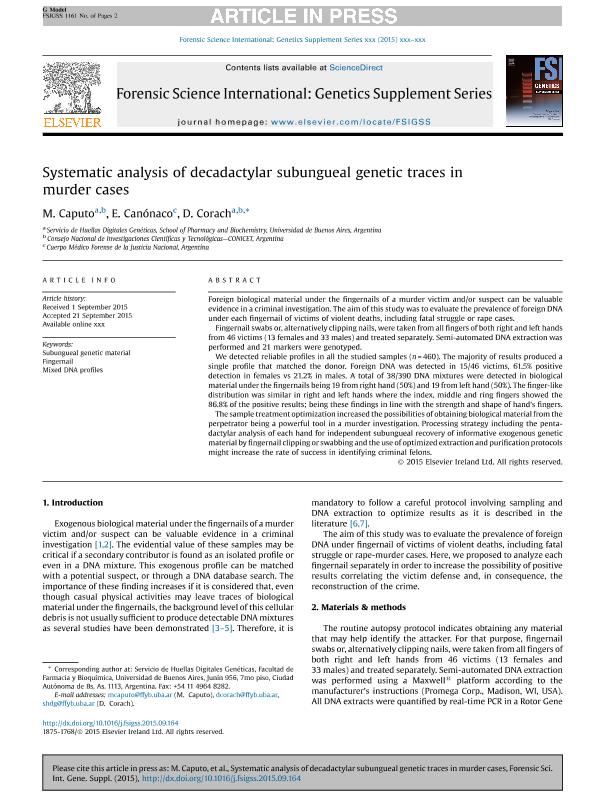Mostrar el registro sencillo del ítem
dc.contributor.author
Caputo, Mariela

dc.contributor.author
Canonaco, Enzo

dc.contributor.author
Corach, Daniel

dc.date.available
2018-03-14T19:15:02Z
dc.date.issued
2015-12
dc.identifier.citation
Caputo, Mariela; Canonaco, Enzo; Corach, Daniel; Systematic analysis of decadactylar subungueal genetic traces in murder cases; Elsevier Ireland Ltd; Forensic Science International: Genetics Supplement Series; 5; 12-2015; e414-e415
dc.identifier.issn
0379-0738
dc.identifier.uri
http://hdl.handle.net/11336/38776
dc.description.abstract
Foreign biological material under the fingernails of a murder victim and/or suspect can be valuable evidence in a criminal investigation. The aim of this study was to evaluate the prevalence of foreign DNA under each fingernail of victims of violent deaths, including fatal struggle or rape cases. Fingernail swabs or, alternatively clipping nails, were taken from all fingers of both right and left hands from 46 victims (13 females and 33 males) and treated separately. Semi-automated DNA extraction was performed and 21 markers were genotyped. We detected reliable profiles in all the studied samples (n = 460). The majority of results produced a single profile that matched the donor. Foreign DNA was detected in 15/46 victims, 61.5% positive detection in females vs 21.2% in males. A total of 38/390 DNA mixtures were detected in biological material under the fingernails being 19 from right hand (50%) and 19 from left hand (50%). The finger-like distribution was similar in right and left hands where the index, middle and ring fingers showed the 86.8% of the positive results; being these findings in line with the strength and shape of hand's fingers. The sample treatment optimization increased the possibilities of obtaining biological material from the perpetrator being a powerful tool in a murder investigation. Processing strategy including the penta-dactylar analysis of each hand for independent subungueal recovery of informative exogenous genetic material by fingernail clipping or swabbing and the use of optimized extraction and purification protocols might increase the rate of success in identifying criminal felons.
dc.format
application/pdf
dc.language.iso
eng
dc.publisher
Elsevier Ireland Ltd

dc.rights
info:eu-repo/semantics/openAccess
dc.rights.uri
https://creativecommons.org/licenses/by-nc-sa/2.5/ar/
dc.subject
Fingernail
dc.subject
Mixed Dna Profiles
dc.subject
Subungueal Genetic Material
dc.subject.classification
Otras Ciencias Biológicas

dc.subject.classification
Ciencias Biológicas

dc.subject.classification
CIENCIAS NATURALES Y EXACTAS

dc.title
Systematic analysis of decadactylar subungueal genetic traces in murder cases
dc.type
info:eu-repo/semantics/article
dc.type
info:ar-repo/semantics/artículo
dc.type
info:eu-repo/semantics/publishedVersion
dc.date.updated
2018-03-14T17:03:47Z
dc.identifier.eissn
1875-175X
dc.journal.volume
5
dc.journal.pagination
e414-e415
dc.journal.pais
Países Bajos

dc.journal.ciudad
Amsterdam
dc.description.fil
Fil: Caputo, Mariela. Universidad de Buenos Aires. Facultad de Farmacia y Bioquímica. Servicio de Huellas Digitales Genéticas; Argentina. Consejo Nacional de Investigaciones Científicas y Técnicas; Argentina
dc.description.fil
Fil: Canonaco, Enzo. Corte Suprema de Justicia de la Nación. Cuerpo Médico Forense; Argentina
dc.description.fil
Fil: Corach, Daniel. Consejo Nacional de Investigaciones Científicas y Técnicas; Argentina. Universidad de Buenos Aires. Facultad de Farmacia y Bioquímica. Servicio de Huellas Digitales Genéticas; Argentina
dc.journal.title
Forensic Science International: Genetics Supplement Series

dc.relation.alternativeid
info:eu-repo/semantics/altIdentifier/doi/http://dx.doi.org/10.1016/j.fsigss.2015.09.164
dc.relation.alternativeid
info:eu-repo/semantics/altIdentifier/url/https://www.sciencedirect.com/science/article/pii/S1875176815302158
Archivos asociados
